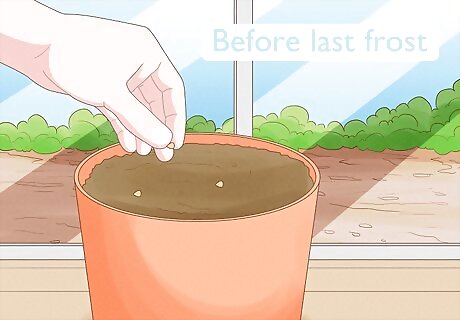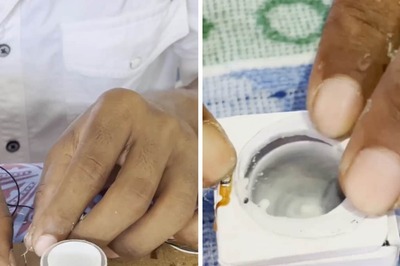
views
Plant your flowers in a sunny spot.

Morning glories require full sun to produce flowers. Your flowers will only open and bloom if they’re in direct sunlight. When you’re planting morning glories, find a spot that gets at least 6 hours of sunlight throughout the day. If you’re keeping morning glories in a container, make sure you place them outside or near a south-facing window so they get as much sunlight as they can throughout the day. Morning glories won’t survive well if you transplant them, so always plant your seeds where you want them to grow for the season. If you notice the leaves have brown edges and look white instead of green, they may have sunscald. Provide a little bit of shade during the hotter afternoon hours to fix it.
Water them once a week.

Too much water encourages leafy growth without blooms. Plants usually don't need to be watered more than once a week, despite what many people might think. Keep a rain gauge or moisture meter in the ground near your morning glories so you can track how much water they get. If it rains during the week, check the meter to see if your plants got 1 inch (2.5 cm) of water. Otherwise, use a watering can or hose to soak the soil. Let the soil dry out between waterings so it doesn’t get too over-saturated. During the hot summer months, it’s normal for the leaves on your morning glories to dry out. That just means your plant is putting its energy into making flowers.
Avoid over-fertilizing.

Rich soil makes morning glories grow more leaves instead of flowers. Morning glories can thrive in poor soil that doesn’t have a lot of nutrients, so you might not need fertilizer at all. Run a soil test to check the nutrient levels in the soil. If you have very poor soil, then only use a 10-10-10 fertilizer once a month to give your plants the nutrients it needs. You can use granular or liquid fertilizer. Avoid using fertilizer that’s high in nitrogen since you won’t get as many flowers from your morning glories. If your plant is dying from over-fertilization, replace the soil and make sure it has enough sunlight. Be careful, though, because really bright lights can cause further stress.
Shelter them from strong wind.

Wind dries out and damages your plants. Keep your morning glories in a spot that’s away from strong gusts of wind. If your plants are already established, put a fence, hedge, or tree upwind to shield them. Whatever you put in will protect an area that’s twice its height, so a 6 ft (1.8 m) fence will keep morning glories safe that are up to 12 feet (3.7 m) away.
Mulch around the stems.

Prevent weeds from sapping nutrients from the soil. Start by pulling out any weeds in the ground so they don’t grow or spread anymore. Spread a 2–3 in (5.1–7.6 cm) layer of organic mulch around the bases of your morning glory stems. Leave 1–2 inches (2.5–5.1 cm) of empty space next to the stem to prevent your morning glories from developing rot. Mulch also helps the soil retain water so your morning glories are less likely to dry out.
Kill pests with insecticidal soap.

Get rid of pesky insects that could damage your flowers. While morning glories are mostly pest-resistant, Japanese beetles, aphids, and spider mites can damage your plants. If you notice them while you’re out in your garden, try picking them off by hand. For a larger infestation, get a natural insecticidal soap and spray it on your morning glories once or twice a week. You can get insecticidal soap from your local gardening center.
Wait until late summer if you planted seeds late.

Morning glories planted in late spring won’t bloom until late summer. Morning glories are already late bloomers, but planting seeds late also affects when you see blooms. During the hotter months of the year, it’s normal if you don’t see as many blooms. Once temperatures go back to normal closer to the fall, your morning glories will produce more flowers. All varieties of morning glories are susceptible to blooming later in the season. Morning glories can bloom through the early fall, so don’t get discouraged if you don’t see flowers right away in the summer.
Start seeds indoors before the last frost.

Starting seeds indoors gives you a head-start on the growing season. If you live in an area that gets snow and frost, avoid planting your seeds directly outside. Start by soaking the seeds overnight in warm water to help them germinate better. Then, plant the seeds in a pot with potting soil. Keep the pot in a spot that’s 65–85 °F (18–29 °C) and wait about a week for the plants to sprout. Once the last risk of frost passes in your area, you can move your flowers outside. Try scraping part of the seed with a file to help it germinate even better.
Plant them in well-draining soil.

Water-logged soil can make your plants develop rot. While you need moist soil for morning glories, it shouldn’t hold water. In the area where you want to plant, dig a hole that’s 1 ft (30 cm) wide and 1 ft (30 cm) deep. Fill it with water and let it absorb into the soil overnight. On the next day, fill the hole with water again. After 1 hour, measure how much the water level dropped. If it went down around 2 inches (5.1 cm), then your soil is perfect for morning glories. If your soil drains too slow or fast, try adding compost or peat moss to help improve the drainage.
Grow your plants near a fence or trellis.

Morning glory vines need vertical support to grow and thrive. Morning glories grow on vines that wrap around vertical structures for support. Whenever you plant morning glories, find a spot that’s near a trellis, arbor, or fence so it spreads out while it grows. Not only will the support keep your plants safe, but it will look beautiful once your flowers start to bloom.


















Comments
0 comment